Atomic architecture’s mission invisible
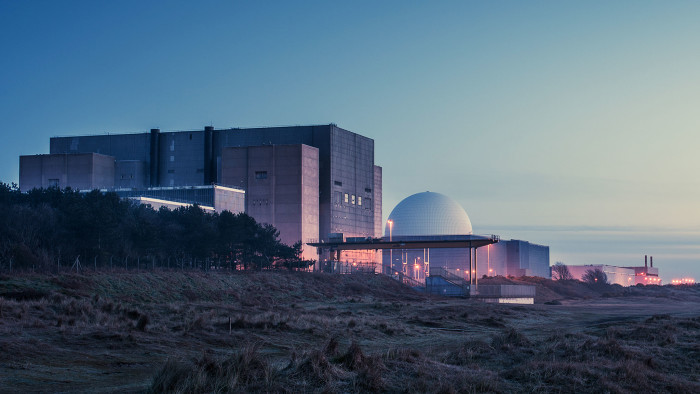
Simply sign up to the Life & Arts myFT Digest -- delivered directly to your inbox.
I suppose that, on a visit to a nuclear power station, every journalist harbours a sneaky, rather weird desire for some kind of incident to break out just at that moment. The sweaty signs of rising panic, the flashing lights, the official denials. The kind of cover-up that James Bridges’ film The China Syndrome, about a TV crew that surreptitiously films a near-disaster, captured so intensely. That film was released just days before a real meltdown at the Three Mile Island nuclear generator in Pennsylvania in 1979. It captured perfectly a 1970s paranoia, just as Alan J Pakula’s The Parallax View had five years earlier.
But, of course, most journalists are never that lucky. Or unlucky. There was a brief fire alarm on the day I visited the Sizewell B power station on England’s Suffolk coast. But it was a test. Touring the plant, I became slightly excited to see a door marked “Outage War Room” so I asked the manager, Martin Cubitt, about it. “Oh yes,” he said. “I think that was from when there was more of an American influence.” What’s in there? I asked. “It’s just a room,” he said. “It’s now called ‘Conference Room 4.’ ” It was one of those days.
Of course, despite my slight disappointment, boring is exactly what we want from our nuclear power plants. Boring — and safe — is good. Fukushima, Chernobyl, Three Mile Island: if we know the names of nuclear power stations, it is almost certainly for the wrong reason. Our culture is saturated with images of nuclear disaster. The nightmarish remains of the explosion in the Ukrainian city of Chernobyl in 1986, the shattered concrete of the power station and the deserted, now eerily overgrown streets of its nearest town, Pripyat, have become the common currency of “ruin porn”. One image frequently used is that of Pripyat’s amusement park, which had been due to be inaugurated on May 1 1986 but was abandoned when disaster struck its nuclear neighbour on April 26. In the images, torn and fading decorations still flutter in the wind.
There is something intangible about these landscapes. The almost otherworldly sense of desolation imparts a special sense of dread. Yet we are compelled, too. From the Fantastic Four to Godzilla, radioactivity permeates popular culture. Homer Simpson, American everyman and perhaps the greatest comic creation of the modern age, works in a nuclear power plant. As he says during his pre-dinner grace: “Thank you most of all for nuclear power, which is yet to cause a single proven fatality. At least in this country.” Homer is, of course, a safety worker.
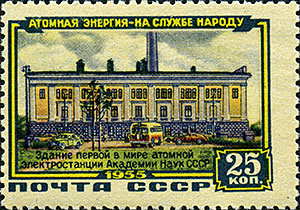
It is no surprise that we want nuclear architecture to be anonymous. But it wasn’t always this way. In 1954, three decades before Chernobyl, the Soviets built the world’s first nuclear power station at Obninsk, just 100km from Moscow. Nikita Khrushchev, who had taken over as Communist party leader after Stalin’s death, was convinced that nuclear power (along with the conquest of space) would be the final phase of the transformation of the Soviet Union into the world’s leading industrial force.
Obninsk was a huge achievement. Less lauded was the fact that it took more power to run than it generated. Undeterred, Soviet scientists ploughed on with a huge nuclear building programme and, to show off their progress, they built the Atomic Energy Pavilion at Moscow’s Expo Park. Opened in the same year as Obninsk, it is a curious building: a white-iced, Baroque wedding cake and a fine example of Socialist Realism, the exuberant neoclassical style favoured by Stalin for palaces of the people. The pavilion made a strange juxtaposition with the modernity of the technology inside but it was admired in the Soviet Union and beyond.
More than 60 years after the opening of that original pavilion, the Russian atomic agency, Rosatom, has launched an architectural competition to design a new one. The agency’s Irina Kireeva explains the thinking behind it: “It will be the first time the nuclear industry has built a national museum,” she says. “But it’s not just about the artefacts and the exhibition — it’s a communication platform where scientists and the public can exchange ideas.”
Russia, with its history of cutbacks in nuclear building programmes and the terrible legacy of Chernobyl, arguably needs this architectural promotion more than anywhere. “This country needs something to be proud of and this is an industry where Russia has real achievements,” says Kireeva. She thinks that the competition will be a rare opportunity for architects to celebrate nuclear power, rather than hiding the extraordinary technology away. “The nuclear pavilion should speak for itself,” she says. “It should be a remarkable construction. It has to communicate.”
…
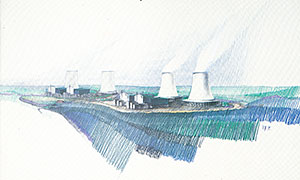
Sizewell B is operated by EDF Energy, a UK subsidiary of the largely state-owned French company that has a history with nuclear architecture. In the 1960s and 1970s, the French not only invested heavily in a nuclear programme, they also once employed avant-garde architects to execute their buildings. The most high-profile of these was Claude Parent, a radical designer whose 1960s experiments in “oblique architecture” (with theorist Paul Virilio) proposed slanting floors and ramps to create a jagged landscape of motion and dynamism. Parent, now 92, was ostracised by his fellow professionals for engaging with nuclear power. The 1970s were the most contentious years for the industry and a high point for environmental activism. But he produced a series of extraordinary studies for future power stations — sculptural forms set against some of France’s most spectacular landscapes. Earlier examination of the German Atlantic bunkers of the second world war, with Virilio, proved useful experience when it came to nuclear architecture.
“We have to remember that these sites needed to be protected in three different ways,” he tells me. “The nuclear core had to be protected; the building had to be protected against radiation; and the site had to be protected against anti-nuclear protesters who, particularly near the borders with Germany, were becoming increasingly organised and aggressive.” The striking architecture, he suggests, came because “the buildings were conceived as bunkers and not designed as mere protection”. Their impenetrability became their essence and their mass allowed them to become part of the landscape. “It is this new landscape that imposes form,” he says. “The rest is detail.”
Parent’s designs were dumbed-down in practice but still remarkable. Unlike their UK counterparts, French nuclear power stations tended to employ cooling towers, which gave an instant architectural presence. At a power plant that was built in 1978 at Cattenom in Moselle, northeast France, a barrage of these towers creates its own landscape of concrete and steam, while the buildings between are more like a Brutalist cultural centre than an industrial structure. The twin towers and twin reactor domes of his power station at Chooz (1967), set in a bend on the river Meuse in Ardennes, make it look like a fortified gateway to some alien world.
…
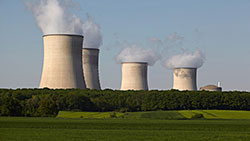
In Britain, home of the world’s first civil nuclear power programme, the architect Sir Basil Spence was commissioned to design one of its earliest power stations, begun in 1959 in Trawsfynydd in Snowdonia, Wales. Spence, the designer of Coventry Cathedral, a symbol of postwar reconstruction, was arguably Britain’s biggest architectural name at the time. Trawsfynydd is an elegant concrete mass that sits somewhere between Sir Giles Gilbert Scott’s brick-mountain Bankside Power Station (now Tate Modern) in London, and a kind of picturesque castle. There had been local opposition to the plans and Spence’s architecture represented an effort to allay fears and to give it presence and dignity.
Walking around the crinkly tin sheds and anonymous industrial landscape of Sizewell B, completed in 1995 and still Britain’s most recent nuclear power station, it seems that either those concerns have died away and the architecture is no longer considered important as a vehicle for reassurance, or that our culture has changed so radically that we now accept banality as an expression of safety. The concrete lump of the neighbouring Sizewell A, which was completed in 1966, still has some of the solidity we might expect from a nuclear power station. Its mass conveys its purpose, the heavy concrete expressed as what it is, an impenetrably dense, protective shell.
At Sizewell B, everything is covered up, clad in the same corrugated metal sheet that has become the default language of anonymous roadside industry. There is no sense of celebration of this extraordinary technology. I asked Ian Bryant, head of planning at EDF Energy, what scope architects had in the design of new nuclear power stations, given the fearsome barrage of regulation they are subject to. “They can try to ensure that they sit into the local environment,” he replies. “Colour can make a real difference.” I’m not entirely sure how they could not sit into their natural environment but it does seem a shame that the architects’ role has been reduced to choosing the paint.
I tried to speak to Grimshaw Architects, which is designing a new £16bn nuclear power station for EDF at Hinkley Point on the north Somerset coast. Surely it would be able to tell me something about the fascinating complexities of designing such a demanding facility. It declined and referred me back to EDF’s PR spokesman. Of course, this caginess comes as no real surprise. Nuclear power is still a delicate subject. Just when it seems to be fading into the background, something big happens.
Sizewell B was being designed in the aftermath of Chernobyl, so perhaps we can forgive its designers their desire for anonymity. It does, at least, have its dome. But every decade brings new fears. There is what Bryant refers to as “the human threat of external hazards”, by which he means the post-9/11 possibility of an aircraft loaded with fuel being flown into a reactor. “A passenger plane used as a weapon wasn’t considered originally and has been built in,” he says. “After Fukushima [in 2011], there was a review and there have been enhancements.” That is as far as he is willing to go.
Bryant, too, justifies the unadorned nature of the new buildings. “There’s an acceptance that these things are driven by function,” he tells me. “Cabe [the Council for Architecture and the Built Environment] applauded the honesty of the structures — that we weren’t just dressing the power stations up.”
But, of course, they are. Those corrugated metal boxes hide extremely interesting contents. I’m taken into the vast turbine hall, an industrial shed of epic proportions. The floor is thrumming with the power of a pair of huge turbines, 300 tonnes of steel, spinning at 3,000rpm. During our tour, Cubitt has to shout above the noise so I can hear him through the ear defenders I’ve been told to wear. He tells me it takes 5m tonnes of seawater a day to cool them.
Even more isolated, understandably, is the control room. It is sited high up, with a wonderful view across the sea. Or rather it would have a wonderful view if it had any windows. “There’s no view — it’s too much of a threat,” David Allan, one of the station’s controllers, tells me cheerily. “You could get distracted, looking out to sea. But it also means you don’t feel drowsy if you’re working the night shift, as you don’t see the dark. It’s exactly the same in here day or night.”
…
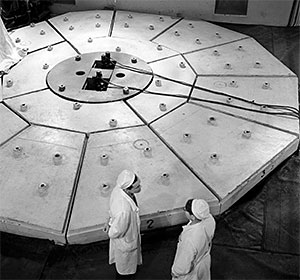
The spirit of atomic architecture survives better in France than it seems to elsewhere. If the awesome power of nuclear fusion can be harnessed, we will achieve abundant energy — and the Iter (International Thermonuclear Reactor) project, a science campus in Caderache, Provence, is where the action is. An international experiment along the lines of Cern, Iter houses the world’s largest tokamak reactor. The architecture of the machine itself is eye-popping, a gleaming torus of sci-fi stainless steel guts and bones. Architects were invited to compete for the designs of the exterior buildings. The best so far are Rudy Ricciotti’s undulating headquarters, which look like they were built from the underside of a mushroom.
Until fusion finally arrives (the physicist’s quip is that it’s always only 30 years away), nuclear power stations will continue to be built. Dozens are under construction across the world. Their growth is the result of the curious paradox that these plants, once seen as harbingers of an imminent apocalypse, are now being espoused as the best way to limit the emission of greenhouse gases; nuclear power, despite reservations about the disposability of radioactive waste, is still far cleaner than that produced by gas- or coal-fired stations.
There doesn’t, however, appear to be much hope that these will be the monuments of the energy of our age. These are not our Hoover Dams or our Battersea Power Stations; they will not become tourist attractions or the museums of the future. In fact, the power companies that build them would rather they were invisible. They don’t want to attract attention and the best way to do that is to pretend they’re just another collection of industrial sheds. Rosatom might strive to celebrate nuclear technology in a pavilion but the power plants themselves, everywhere in the world, deliberately fail to celebrate anything. This is the aesthetic of safety and reassurance. Nothing to see here.
Edwin Heathcote is the FT’s architecture critic
Photographs: Harry CoryWright; Topfoto; Thomas Frey/Corbis; Valentin Kunov/Corbis
Comments